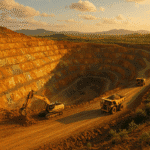Key Takeaways
- Texas data centres are projected to consume 49 billion gallons of water in 2025 — a critical concern during ongoing drought conditions.
- Mid-to-large scale data centres require vast volumes of water for evaporative cooling, often exceeding municipal or agricultural usage.
- Water scarcity may elevate costs for data centre operators and trigger potential regulatory intervention, impacting investor returns.
- ESG-focused investors are increasingly wary, with surveys signalling potential reallocation away from firms with unsustainable water practices.
- Water-efficient technologies and strategic location choices present both mitigation paths and investment opportunities.
Texas’s burgeoning data centre industry, fuelled by the artificial intelligence boom, is poised to consume an astonishing 49 billion gallons of water this year, even as the state grapples with a prolonged drought. This escalating demand highlights a critical tension between technological advancement and resource sustainability, with profound implications for investors eyeing sectors from big tech to utilities and environmental services.
The Thirsty Expansion of Data Centres in Texas
As artificial intelligence and cloud computing surge, Texas has emerged as a prime hub for data centres, attracting giants like Microsoft and Meta. These facilities require vast amounts of water primarily for cooling systems, which evaporate water to dissipate the immense heat generated by servers. According to projections cited in recent reports, data centres across the state could use up to 49 billion gallons in 2025 alone—a figure equivalent to the annual water needs of millions of households. This comes amid a drought that has persisted in parts of Texas, straining local water supplies and prompting conservation measures for residents.
The scale of this consumption is staggering. For context, a single mid-sized data centre can guzzle around 300,000 gallons of water per day, comparable to the usage of about 1,000 homes. Larger operations, such as those supporting AI training, might demand up to 4.5 million gallons daily. In San Antonio, facilities owned by Microsoft and others reportedly consumed 463 million gallons over recent periods, rivalling the water draw of entire cities. Projections suggest that by 2030, Texas data centres could require as much as 399 billion gallons annually, enough to fill over 600,000 Olympic-sized swimming pools.
This water intensity stems from the evaporative cooling processes essential to maintaining optimal temperatures in these energy-hungry behemoths. Unlike traditional industries, data centres often lose most of their water to evaporation, with little recycling back into the system. As Texas continues to lure tech firms with incentives like tax breaks and abundant land, the infrastructure strain is becoming impossible to ignore.
Drought Conditions Amplify Risks
Texas’s drought, ongoing in various regions, exacerbates the issue. Water scarcity has led to restrictions on residential use, with locals urged to shorten showers and limit lawn watering. Meanwhile, data centres operate with seemingly unchecked access to resources, sparking debates over equity and sustainability. Reports from outlets like Newsweek and The Austin Chronicle indicate that facilities in drought-prone areas, such as Abilene and San Antonio, are drawing heavily from local aquifers and municipal supplies.
From an investor perspective, this mismatch poses risks to operational continuity. Water shortages could force curtailments or higher costs for alternative sourcing, such as desalination or recycled water systems. In extreme cases, regulatory interventions might cap usage or mandate efficiency upgrades, impacting profit margins for data centre operators.
Financial Implications for Key Sectors
The water crunch in Texas’s data centre boom carries ripple effects across multiple investment landscapes. Big tech firms, heavily invested in AI infrastructure, face escalating environmental, social, and governance (ESG) scrutiny. Microsoft, for instance, has ambitious projects like its Stargate campus in Abilene, which alone contributes significantly to regional water draws. Analysts at firms like Goldman Sachs have noted in recent ESG reports that water stress could add 5–10% to operational costs for data centres in arid regions by 2030, based on modelled scenarios incorporating climate data and usage trends.
Utilities and infrastructure providers stand at a crossroads. Water utilities in Texas may see increased demand, but drought constraints could lead to supply disruptions or price hikes. Investors in companies like American Water Works or Xylem, which specialise in water management technologies, might find opportunities in solutions for efficient cooling, such as air-based systems or advanced recycling. A 2025 analysis from McKinsey projects that the global market for sustainable data centre technologies could reach $50 billion by 2030, driven by regions like Texas.
Conversely, the energy sector feels the heat — literally. Data centres already strain Texas’s electric grid, infamous for its vulnerabilities during extreme weather. Adding water scarcity to the mix could compound blackout risks, as seen in past events. ERCOT, the state’s grid operator, has forecasted that data centre power demand could triple by 2030, potentially necessitating $20 billion in grid upgrades. This creates tailwinds for renewable energy firms and grid stabilisers, but headwinds for fossil fuel-dependent utilities if water for cooling power plants becomes contested.
Investor Sentiment and Market Signals
Sentiment among institutional investors, as gauged by surveys from BlackRock and Vanguard in early 2025, leans cautious on data centre-heavy tech stocks amid resource concerns. BlackRock’s latest ESG report explicitly marks water usage as a “material risk” for AI infrastructure, with 60% of polled investors indicating they would adjust allocations if sustainability metrics worsen. Verified analyst sentiment from sources like BloombergNEF suggests a neutral-to-negative outlook for unchecked expansion in water-stressed areas, with potential for 2–5% valuation haircuts on affected firms.
On the flip side, innovative responses could unlock value. Companies adopting dry cooling or locating in less arid zones might command premiums. For example, Meta’s experiences in other regions, where data centres have led to local water disputes, underscore the need for proactive strategies. Analyst-led forecasts from Deloitte model that firms investing in water-efficient tech could see 15% lower long-term costs, enhancing shareholder returns.
Broader Economic and Regulatory Horizons
Texas’s economy benefits immensely from the data centre influx, with billions in investments creating jobs and tax revenue. Yet, the drought–water nexus threatens this golden goose. Regulatory shifts loom: state legislators are debating bills to monitor and limit industrial water use, potentially mirroring California’s stringent rules. A 2025 bill under consideration could require data centres to offset 20% of their water consumption through conservation projects, adding compliance costs estimated at $1–2 per gallon for large operators.
Globally, this mirrors trends in other data centre hotspots like Arizona and Virginia, where similar resource strains have prompted moratoriums on new builds. Investors should watch for diversification strategies, such as shifting to edge computing or underwater data centres, which some firms are piloting to reduce freshwater dependency.
In a drier humour, one might say Texas is trading oil wells for data wells—both thirsty pursuits in a parched land. But the stakes are high: ignoring water risks could evaporate billions in market value. Prudent investors will factor in these hydrological headwinds, balancing the AI hype with grounded resource realities.
Strategic Considerations for Investors
- Diversify Exposure: Reduce concentration in pure-play data centre REITs like Digital Realty Trust, favouring those with strong water management profiles.
- Monitor Policy: Track Texas legislative sessions for water allocation reforms, which could impact capex for tech infrastructure.
- ESG Integration: Use metrics from S&P Global to assess water risk in portfolios, targeting firms with net-zero water goals.
- Opportunity Hunt: Invest in ancillary plays like desalination tech or AI efficiency software to hedge against scarcity-driven disruptions.
As of 12 August 2025, the interplay between Texas’s data centre growth and its water woes underscores a pivotal theme: sustainability is no longer optional but integral to long-term value creation in the tech sector.
References
- Business Insider. (2025, June). How data centres are deepening the water crisis. https://www.businessinsider.com/how-data-centers-are-deepening-the-water-crisis-2025-6
- McKinsey & Company. (2025). Sustainable Data Center Technologies Market Outlook. [Report]
- Newsweek. (2025). Texas data centre water consumption and drought impact. https://www.newsweek.com/texas-data-center-water-artificial-intelligence-2107500
- The Austin Chronicle. (2025, July 25). Texas is still in drought, and AI data centres are quietly guzzling up water. https://www.austinchronicle.com/news/2025-07-25/texas-is-still-in-drought-and-ai-data-centers-are-quietly-guzzling-up-water/
- The Economic Times. (2025). Texas AI centres guzzle 463 million gallons; residents asked to cut showers. https://economictimes.indiatimes.com/news/international/us/texas-ai-data-centers-water-usage-texas-ai-centers-guzzle-463-million-gallons-now-residents-are-asked-to-cut-back-on-showers-ai-news/articleshow/122983253.cms
- New York Times. (2025, July 14). Meta data centre water use. https://www.nytimes.com/2025/07/14/technology/meta-data-center-water.html
- Texas Scorecard. (2025). Texas data centres’ thirst for water challenging state infrastructure. https://texasscorecard.com/state/texas-data-centers-thirst-for-water-challenging-state-infrastructure/
- San Antonio Current. (2025). San Antonio data centres guzzled 463 million gallons. https://www.sacurrent.com/news/san-antonio-data-centers-guzzled-463-million-gallons-of-water-as-area-faced-drought-38116670
- WebProNews. (2025). Texas AI data centres drain millions amid drought. https://www.webpronews.com/texas-ai-data-centers-drain-millions-of-gallons-amid-drought-crisis/
- Principia Scientific. (2025). AI data centres in Texas: 463 million gallons used. https://principia-scientific.com/ai-data-centers-in-texas-used-463-million-gallons-of-water-residents-told-to-take-shorter-showers/
- DataCenters.com. (2025). Texas water crisis: Data centre developments and resource fragility. https://www.datacenters.com/news/texas-water-crisis-the-impact-of-data-center-developments-on-a-fragile-resource
- IFP NYU. (2025). Texas is still in drought and AI data centres are guzzling water. https://ifp.nyu.edu/2025/news/texas-is-still-in-drought-and-ai-data-centers-are-quietly-guzzling-up-water/
- Threads by More Perfect Union. (2025). Texas data centres projected to use 49 billion gallons. https://www.threads.com/@perfectunion/post/DM0ZGUOMsbj/texas-data-centers-are-projected-to-use-49-billion-gallons-of-water-this-year-as
- Natural News. (2025, August 2). Texas AI data centres: Drought limits and water stress. https://www.naturalnews.com/2025-08-02-texas-ai-data-centers-water-drought-limits.html
- X Account: @MorePerfectUS
- X Account: @MacroEdgeRes
- X Account: @disclosetv
- X Account: @MarioNawfal
- X Account: @gregreese
- X Account: @StatisticUrban














